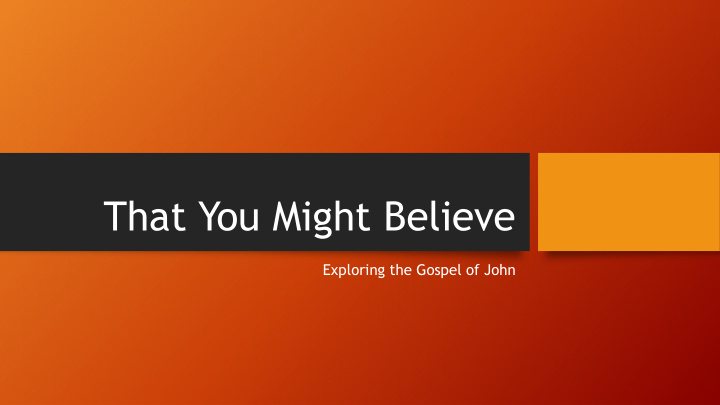



That You Might Believe Exploring the Gospel of John
The Multiple Source Hypothesis Lk Jo John hn Q Mark Mt Stories about Jesus Matthew Luke
Mark? Matthew? John’s Theo- Luke? Jo John hn logical Lens Different Stories about Jesus
Who? • Purports to be an eyewitness (21:20-24) • Clearly familiar with geography of Judea and Jerusalem • The “beloved disciple” • Identified with John, son of Zebedee • Never explicitly named within the Gospel • First-generation Christian, possibly one of the apostles • (Plus an editor/amender!)
Where and when? • Two key debates • Within Christianity: What about the Gentiles? • Does becoming a Christian require becoming Jewish first? • Are Gentile Christians required to keep Torah? • Within Judaism: What about the Christians? • Are they another sect within Judaism? • Or are they something different entirely?
“Siege and Destruction of Jerusalem by the Romans”, by David Roberts, 1850 http://www.preteristarchive.com/ARTchive/1850_roberts_destruction-jerusalem.html, Public Domain, https://commons.wikimedia.org/w/index.php?curid=3267412
Where and when? • Two key debates • Within Christianity: What about the Gentiles? • Within Judaism: What about the Christians? • Two key events • Destruction of Jerusalem and the Second Temple in 70 A.D. • Primary focus of Jewish religious life shifts to local synagogues
Bust of Emperor Gaius Julius Caesar Augustus Germanicus, better known as Caligula, in the Palazzo Massimo in Rome. By Tomk2ski - Own work, CC BY-SA 4.0, https://commons.wikimedia.org/w/index.php?curid=46094041
Where and when? • Two key debates • Within Christianity: What about the Gentiles? • Within Judaism: What about the Christians? • Two key events • Destruction of Jerusalem and the Second Temple in 70 A.D. • Primary focus of Jewish religious life shifts to local synagogues • Separation of Christianity from the synagogues • Loss of protection for monotheism • Unclear which side drove separation
Where and when? • John is believed to be written after the separation from the synagogues • Christianity is becoming predominantly Gentile, but still with strong Jewish roots • Stylistic similarity to other early Christian documents from Asia (Turkey) and Antioch (Syria) • Typically dated in the early 90s
What and Why? A Unique Account • Distinctly different point of view and approach • Includes a lot not found in the Synoptics • Excludes a lot that is in the Synoptics • Shared material extensively reworked • Long sections of teaching not found elsewhere • Less emphasis on (or different?) sacraments • Passion narrative even more dominant • Strikingly different theology in some important ways
What and Why? A “Spiritual Gospel” • Reflective rather than descriptive • Less concerned with what happened than with what it means • Much higher Christology • Revelation of the divine character • Explaining why some believe and others don’t • Encouraging belief as first generation witnesses pass away • Encouraging resilience in the face of persecution
How: John’s Narrative Structure • Prologue and Preparation (1:1-51) • Ministry of Revelation (2:1-12:50) • Passion (13:1-19:42) • Vindication (20:1-31) • Epilogue (21:1-25)
How: John’s Narrative Structure • Prologue and Preparation (1:1-51) • Ministry of Revelation (2:1-12:50) • Public signs, teaching, conflict • Passion (13:1-19:42) • Private revelation to disciples • Arrest, judgment, and glorification • Vindication (20:1-31) • Empty tomb • Resurrection appearances • Epilogue (21:1-25)
• Revelation to Disciples (13:1-17:26) • Arrest, Judgment, Glorification (18:1-19:42)
For next time… • Read John as a story • Note any AHA! or HUH? moments • Send your comments or questions
Next Session… Examining John’s Theology (Part 1)
Recommend
More recommend